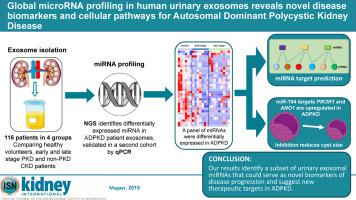Kidney International ( IF 14.8 ) Pub Date : 2020-03-06 , DOI: 10.1016/j.kint.2020.02.008 Tajdida A Magayr 1 , Xuewen Song 2 , Andrew J Streets 1 , Laura Vergoz 1 , Lijun Chang 1 , Manoj K Valluru 1 , Hsiu L Yap 3 , Morgane Lannoy 1 , Amirreza Haghighi 2 , Roslyn J Simms 1 , Frederick W K Tam 3 , York Pei 2 , Albert C M Ong 1

|
MicroRNAs (miRNAs) play an important role in regulating gene expression in health and disease but their role in modifying disease expression in Autosomal Dominant Polycystic Kidney Disease (ADPKD) remains uncertain. Here, we profiled human urinary exosome miRNA by global small RNA-sequencing in an initial discovery cohort of seven patients with ADPKD with early disease (eGFR over 60ml/min/1.73m2), nine with late disease (eGFR under 60ml/min/1.73m2), and compared their differential expression with six age and sex matched healthy controls. Two kidney-enriched candidate miRNA families were identified (miR-192/miR-194-2 and miR-30) and selected for confirmatory testing in a 60 patient validation cohort by quantitative polymerase chain reaction. We confirmed that miR-192-5p, miR-194-5p, miR-30a-5p, miR-30d-5p and miR-30e-5p were significantly downregulated in patient urine exosomes, in murine Pkd1 cystic kidneys and in human PKD1 cystic kidney tissue. All five miRNAs showed significant correlations with baseline eGFR and ultrasound-determined mean kidney length and improved the diagnostic performance (area under the curve) of mean kidney length for the rate of disease progression. Finally, inverse correlations of these two miRNA families with increased expression in their predicted target genes in patient PKD1 cystic tissue identified dysregulated pathways and transcriptional networks including novel interactions between miR-194-5p and two potentially relevant candidate genes, PIK3R1 and ANO1. Thus, our results identify a subset of urinary exosomal miRNAs that could serve as novel biomarkers of disease progression and suggest new therapeutic targets in ADPKD.
中文翻译:

人类尿液外泌体的全球microRNA分析揭示了常染色体显性多囊肾疾病的新型疾病生物标志物和细胞途径。
MicroRNA(miRNA)在调节健康和疾病中的基因表达中起着重要作用,但它们在常染色体显性多囊肾病(ADPKD)中修饰疾病表达的作用仍不确定。在这里,我们通过全球小RNA测序对人类尿液外泌体miRNA的概况进行了研究,该队列最初包括7名患有早期疾病(eGFR超过60ml / min / 1.73m 2)的ADPKD患者,9名患有晚期疾病(eGFR低于60ml / min / 1.73m 2),并将其差异表达与六个年龄和性别相匹配的健康对照进行比较。鉴定了两个肾脏富集的候选miRNA家族(miR-192 / miR-194-2和miR-30),并通过定量聚合酶链反应在60例患者验证队列中选择用于验证性测试。我们证实,患者尿液外泌体,鼠Pkd1囊性肾脏和人PKD1中miR-192-5p,miR-194-5p,miR-30a-5p,miR-30d-5p和miR-30e-5p均显着下调。胆囊肾组织。所有五个miRNA均显示与基线eGFR和超声确定的平均肾脏长度显着相关,并改善了平均肾脏长度对疾病进展速度的诊断性能(曲线下的面积)。最后,这两个miRNA家族与其在患者PKD1囊性组织中的预测靶基因中表达增加的负相关关系确定了失调的途径和转录网络,包括miR-194-5p与两个潜在相关候选基因PIK3R1和ANO1之间的新型相互作用。因此,我们的研究结果确定了尿液外泌体miRNA的一个子集,可以作为疾病进展的新生物标记,并在ADPKD中提出新的治疗靶标。









































 京公网安备 11010802027423号
京公网安备 11010802027423号